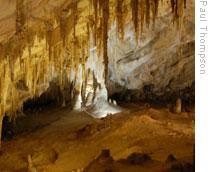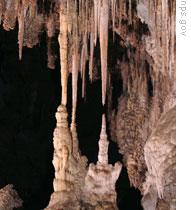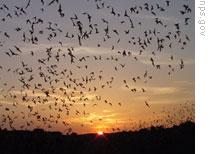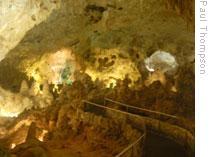VOA慢速英语 2008 1006b
时间:2019-01-11 作者:英语课 分类:VOA慢速英语2008(十)月
Welcome to THIS IS AMERICA in VOA Special English. I'm Bob Doughty 1.
VOICE TWO:
And I'm Barbara Klein. This week on our program, we explore a UNESCO World Heritage Site in the American Southwest, near the city of Carlsbad, New Mexico. Carlsbad Caverns 3 National Park contains more than one hundred caves below the surface of the desert. Most are closed to the public. But anyone can visit the main attraction, one of the largest caves in the world.
(MUSIC)
VOICE ONE:

Kings Palace Room in Carlsbad Cavern 2
Huge. Incredible. Inspiring. Words like these come to mind as visitors enter a world of silence, darkness and cold, almost two hundred thirty meters under the ground.
An elevator lowers you into the world of Carlsbad Cavern, the big cave at Carlsbad Caverns National Park. Silent, except for the voices of guides and visitors. And not completely dark. The National Park Service has enough lighting 4 to see many of the beautiful formations all around. The temperature is about thirteen degrees Celsius 5.
A cavern is a large cave. But Carlsbad Cavern is really a long series of chambers 7. One of these is called the Big Room. The Big Room is more than three hectares big. The ceiling is seventy-seven meters high. The Big Room is the single largest underground chamber 6 ever found in North America.
VOICE TWO:

Examples of stalactites and stalagmites
The Big Room and other parts of the cavern contain huge, sharp formations of minerals. People are free to explore the lit formations in the Big Room. But park rangers 9 must guide visitors to other areas of the cave.
Stalactites hang from the ceiling. Stalagmites rise from the floor. Some even meet to create a column. Other formations look like needles, popcorn 10, pearls and flowers.
A visitor still remembers the memory aid she learned long ago from her fifth-grade teacher. Stalactites have to hang on tight to the ceiling or they might fall off. And be careful about stalagmites -- you might trip over one on the floor.
(MUSIC)
VOICE ONE:
One of the first questions that visitors have is how did Carlsbad Cavern form? Guides explain that it did not result from the action of water and streams like other limestone 11 caves. Instead, it was created by the action of sulfuric acid.
The limestone developed about two hundred fifty million years ago. Then, within the last twenty million years, movements in the earth pushed the rock upward, forming the Guadalupe Mountains. Today these mountains extend from west Texas into southeast New Mexico.
The action of oil and natural gas created hydrogen sulfide in the limestone. The hydrogen sulfide reacted with oxygen in rainwater moving through the rock. Sulfuric acid developed. The acid created the caves by dissolving the limestone in its path.
Later, the water and most of the acid left the caves as the Guadalupe Mountains continued to rise. This permitted freshwater to move through. The freshwater left behind minerals. These minerals became the formations and shapes on the ceilings, walls and floors of the caves.
(MUSIC)
VOICE TWO:
People are not the only ones who visit Carlsbad Caverns National Park. About four hundred thousand Mexican free-tailed bats come to the big cave from Mexico each summer to give birth.

Thousands of bats fly out of the natural entrance of the cave
Every evening, as the sun goes down, thousands of adult bats fly out of the natural entrance of the cave. It can take from twenty minutes to more than two hours for them all to leave. The bats fly to nearby river valleys to feed on night-flying insects. Then, toward morning, they return to the bat cave within Carlsbad Cavern.
Park Service rangers explain that mother bats find their babies by remembering their location, their smell and the sound of their cry. Mothers and pups hang in groups on the ceiling. They spend the day resting and feeding.
While the adults go out at night for food, the young bats hang out in the cave for four or five weeks. Then, in July or August, they join their mothers on these nightly flights.
Finally, in late October or early November, the bats all leave and return to Mexico. But they always return the next year.
(MUSIC)
VOICE ONE:
It is easy to imagine that it was the bats that led ancient people to discover the cave. Archeologists and others have found evidence of Ice Age hunters near the cave entrance. They have also found pieces of spear points left about ten thousand years ago.
More recently, Apache Indians painted pictures at the entrance. And evidence of one of their cooking areas was found beside a nearby path.
Around nineteen hundred, a teenage cowboy named James Larkin White began to explore the cave.
Jim White told his story in the nineteen thirty-two book "The Discovery and History of Carlsbad Caverns." Here is a reading of his description of his first sight of the bats and the big cave:
READER:

Jim White inside Carlsbad Cavern
"I thought it was a volcano, but then, I'd never seen a volcano -- nor never before had I seen bats swarm 12, for that matter. During my life on the range I'd seen plenty of prairie whirlwinds -- but this thing didn't move; it remained in one spot, spinning its way upward. I watched it for perhaps a half-hour -- until my curiosity got the better of me. Then I began investigating …
"I worked my way through the rocks and brush until I found myself gazing into the biggest and blackest hole I had ever seen, out of which the bats seemed literally 13 to boil …
"The more I thought of it the more I realized that any hole in the ground that could house such a gigantic army of bats must be a whale of a big cave … I crept between cactus 14 until I lay on the brink 15 of the chasm 16, and looked down. During all the years I'd know of the place, I'd never taken the trouble to do this. There was no bottom in sight! I shall never forget the feeling of aweness it gave me."
VOICE TWO:
Jim White told how he built a ladder from rope, wire and sticks and returned to the entrance of the cave a few days later.
READER:
"I found myself climbing down, down, deeper and deeper into the blackness ... At last my feet touched something solid. I lighted my lantern, and found that I was perched on a narrow ledge 17, almost at the end of my rope -- literally and figuratively.
"By now I could see into the tunnel -- it wasn't much farther down to the floor of it, and that floor looked smooth and level. I decided 18 that with a little exhibition of human-fly stuff, I could hold onto the rough wall and go down another twenty feet to level territory.
"Standing 19 at the entrance of the tunnel I could see ahead of me a darkness so absolutely black it seemed a solid. The light of my lantern was but a sickly glow. Nevertheless, I forged ahead, and with each step the tunnel grew larger, and I felt as though I was wandering into the very core of the Guadalupe Mountains."
VOICE ONE:
A few years later, a settler named Abijah Long also found the entrance and went into the cavern. He found huge amounts of bat droppings. Abijah Long hired local workers to mine the guano which he sold to farmers as fertilizer. At the same time, he explored much of the caves. Some people might even say Abijah Long was the first real explorer of Carlsbad Cavern.
But Jim White made it his life's work to make sure the public would see and enjoy the cavern. He worked on Abijah Long's mining operation for twenty years.
The authors of the book "Carlsbad Cavern: The Early Years" say Jim White took the job for the chance to keep exploring the cave. And after the mining operation closed, he started building paths in the cavern. Yet once he had enough paths built to welcome visitors, no one seemed interested in his "bat cave."
VOICE TWO:
Then, in nineteen eighteen, Jim White took a professional photographer into the cave. Ray Davis' pictures of the Big Room appeared in the New York Times. National interest began to grow.
In nineteen twenty-three, scientists from the National Geographic 20 Society explored the caves. The following year, President Calvin Coolidge named Carlsbad a national monument. Presidents can declare national monuments, but Congress must act to establish a national park. And that is what Congress did in nineteen thirty.
VOICE ONE:

A walking path in the Big Room
Since then, parts of Carlsbad Caverns have been used for movie sets, weddings, even meetings of the Carlsbad City Council.
Park official Marie Merrick says more than four hundred thousand people visited Carlsbad Caverns in two thousand seven. Most visitors go to the main cavern. But some experienced cavers are permitted to explore five "wild" caves in the park. And in another one, scientists are studying microbes in search of a cure for cancer.
VOICE TWO:
As for Jim White, he became chief ranger 8 of Carlsbad Caverns. In his story in the book "The Discovery and History of Carlsbad Caverns," he talks about all the work that was done.
READER:
"I doubt if you can understand how happy this modernizing 21 has made me. It's like the pleasant end to a dream."
(MUSIC)
VOICE ONE:
Our program was written by Nancy Steinbach and produced by Dana Demange. I'm Bob Doughty.
VOICE TWO:
And I'm Barbara Klein. Doug Johnson was our reader. You can discover pictures of the big cave at Carlsbad Caverns, along with transcripts 22, MP3s and podcasts of our programs, at voaspecialenglish.com. Join us again next week for THIS IS AMERICA in VOA Special English.
- Most of successful men have the characteristics of contumacy and doughty.绝大多数成功人士都有共同的特质:脾气倔强,性格刚强。
- The doughty old man battled his illness with fierce determination.坚强的老人用巨大毅力与疾病作斗争。
- The cavern walls echoed his cries.大山洞的四壁回响着他的喊声。
- It suddenly began to shower,and we took refuge in the cavern.天突然下起雨来,我们在一个山洞里避雨。
- Within were dark caverns; what was inside them, no one could see. 里面是一个黑洞,这里面有什么东西,谁也望不见。 来自汉英文学 - 家(1-26) - 家(1-26)
- UNDERGROUND Under water grottos, caverns Filled with apes That eat figs. 在水帘洞里,挤满了猿争吃无花果。
- The gas lamp gradually lost ground to electric lighting.煤气灯逐渐为电灯所代替。
- The lighting in that restaurant is soft and romantic.那个餐馆照明柔和而且浪漫。
- The temperature tonight will fall to seven degrees Celsius.今晚气温将下降到七摄氏度。
- The maximum temperature in July may be 36 degrees Celsius.七月份最高温度可能达到36摄氏度。
- For many,the dentist's surgery remains a torture chamber.对许多人来说,牙医的治疗室一直是间受刑室。
- The chamber was ablaze with light.会议厅里灯火辉煌。
- The body will be removed into one of the cold storage chambers. 尸体将被移到一个冷冻间里。 来自《简明英汉词典》
- Mr Chambers's readable book concentrates on the middle passage: the time Ransome spent in Russia. Chambers先生的这本值得一看的书重点在中间:Ransome在俄国的那几年。 来自互联网
- He was the head ranger of the national park.他曾是国家公园的首席看守员。
- He loved working as a ranger.他喜欢做护林人。
- Do you know where the Rangers Stadium is? 你知道Rangers体育场在哪吗? 来自超越目标英语 第3册
- Now I'm a Rangers' fan, so I like to be near the stadium. 现在我是Rangers的爱好者,所以我想离体育场近一点。 来自超越目标英语 第3册
- I like to eat popcorn when I am watching TV play at home.当我在家观看电视剧时,喜欢吃爆米花。
- He still stood behind his cash register stuffing his mouth with popcorn.他仍站在收银机后,嘴里塞满了爆米花。
- Limestone is often used in building construction.石灰岩常用于建筑。
- Cement is made from limestone.水泥是由石灰石制成的。
- There is a swarm of bees in the tree.这树上有一窝蜜蜂。
- A swarm of ants are moving busily.一群蚂蚁正在忙碌地搬家。
- He translated the passage literally.他逐字逐句地翻译这段文字。
- Sometimes she would not sit down till she was literally faint.有时候,她不走到真正要昏厥了,决不肯坐下来。
- It was the first year that the cactus had produced flowers.这是这棵仙人掌第一年开花。
- The giant cactus is the vegetable skycraper.高大的仙人掌是植物界巨人。
- The tree grew on the brink of the cliff.那棵树生长在峭壁的边缘。
- The two countries were poised on the brink of war.这两个国家处于交战的边缘。
- There's a chasm between rich and poor in that society.那社会中存在着贫富差距。
- A huge chasm gaped before them.他们面前有个巨大的裂痕。
- They paid out the line to lower him to the ledge.他们放出绳子使他降到那块岩石的突出部分。
- Suddenly he struck his toe on a rocky ledge and fell.突然他的脚趾绊在一块突出的岩石上,摔倒了。
- This gave them a decided advantage over their opponents.这使他们比对手具有明显的优势。
- There is a decided difference between British and Chinese way of greeting.英国人和中国人打招呼的方式有很明显的区别。
- After the earthquake only a few houses were left standing.地震过后只有几幢房屋还立着。
- They're standing out against any change in the law.他们坚决反对对法律做任何修改。
- The city's success owes much to its geographic position. 这座城市的成功很大程度上归功于它的地理位置。 来自《简明英汉词典》
- Environmental problems pay no heed to these geographic lines. 环境问题并不理会这些地理界限。 来自英汉非文学 - 环境法 - 环境法
- Modernizing a business to increase its profitability and competitiveness is a complicated affair. 使企业现代化,从而达到增加利润,增强竞争力的目的,是一件复杂的事情。
- The young engineer had a large share in modernizing the factory. 这位年轻工程师在工厂现代化的过程中尽了很大的“力”。
- Like mRNA, both tRNA and rRNA are transcripts of chromosomal DNA. tRNA及rRNA同mRNA一样,都是染色体DNA的转录产物。 来自辞典例句
- You can't take the transfer students'exam without your transcripts. 没有成绩证明书,你就不能参加转学考试。 来自辞典例句